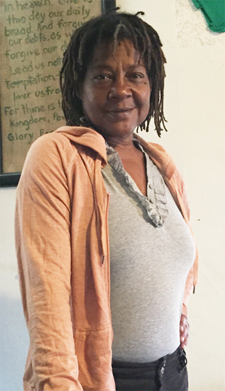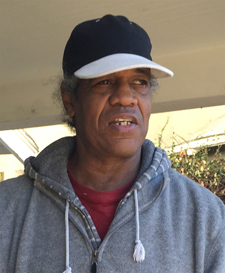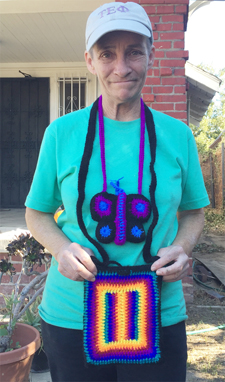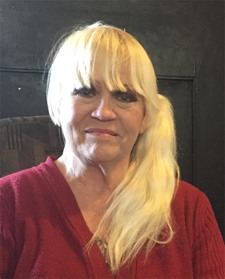Voices of Homelessness
- Details
- Category: Community News
- Published on Thursday, 10 December 2015 22:41
- Written by Carla Pineda
 Tammy Lee-Crout
Tammy Lee-CroutAge: 55
Time homeless: Moved from her government-subsidized home into supportive housing
An activist at heart, Tammy Lee-Crout was already close to the homeless community for a long time. However, she has learned a lot about the realities of homelessness since she lost her own home three months ago.
“I call myself the newly homeless because 13,000 households are becoming homeless in Los Angeles every month. I’m one of them.”
For six years, Lee-Crout lived in the West Adams region, near the Rancho Cienega Recreation Center.
“Everybody used to call my house ‘Sister Lee’s house.’ You’d get good meals. You ate what I ate and I was eating good.”
The Little Rock, AK native’s stable situation collapsed Section 8 ended her housing subsidy on charges of accommodating unauthorized tenants. However, Lee-Crout argues these people were not tenants. They were homeless people who stored things in her home, stopped by to charge their phones, or crashed for a night or two.
“Fellowshipping. But that’s not something the City of Los Angeles wants public housing citizens to do. We are not supposed to help other homeless.”
After several months of missed utility payments, stolen identity disputes, and cancelled housing assistance checks, Lee-Crout ran out of resources to maintain her home solely with her disability benefits. She moved to Natural Ivy Foundation’s housing in August 2015.
On a chilly November evening, Lee-Crout recalls all the belongings she had to leave behind. “I didn’t even have a chance to bring my winter clothes. I had a coat for every occasion.”
In her experience with both, helping and facing homelessness, Lee-Crout has met many working people who owned their homes but lost them due to faulty mortgages.
“I see so many people becoming homeless, not just people who have public assistance. Just a single will run you $1,000 and people on social service don’t even have $1,000.”
Lee-Crout is full of ideas and suggestions to tackle homelessness from the bottom up.
“I would like to see more citizen involvement. Citizens should be able to help the homeless without any retribution."
She wants to see more independent housing for the newly homeless, in addition to more bridge and supportive housing where individuals can find counseling services, a healthy meal, and a warm shower.
"These facilities should be located throughout the city so displaced people can remain within their communities, where they belong and are most valuable. Each council district should be taking care of their own homeless instead of shipping everyone down to Skid Row. That’s a whole other world where most of the people who are there are chronically homeless. Many are psychotic and have mental issues.”
She also suggests the city offer more tax credits to encourage investors to build more facilities, and for banks and government agencies to coordinate on the conversion of foreclosed homes into multi-unit supportive homes.
Despite her current situation, Lee-Crout’s mind is racing with projects to serve her community. She is excited about getting her Cyber Reading Stars idea off the ground.
"I want to establish this digital reading and mentoring program where you can log in from anywhere… We’ll raise money for the homeless in L.A.. I want to raise money for Natural Ivy Foundation, for Elvis Summers and the Tiny House Project, and I’m looking for others that do something to help the homeless. I have to be proactive in changing some of the rules that are against humanity… God wanted me to see this so I can be more of an advocate. I had no idea that it was this bad.”
 Sharon Ortiz & Lue Simon
Sharon Ortiz & Lue SimonAge: 60 & 63 (respectively)
Time homeless: 3 years permanently, more than 15 years intermittently
Lue Simon jokes that it would be dangerous to listen to every story he and his cousin Sharon Ortiz have experienced during their more than 15 years on the streets.
“It’s really scary out there but we’ve been blessed and fortunate that we’ve been able to survive as long as we have.”
The blind Simon and critically ill Ortiz have been rejected from housing programs, threatened by family, and ignored by different agencies, not to mention bizarre domestic terrorism and violent attacks.
“For years, I’m fighting. I’m dying. I’m done. I’m to the point where I wish I would pass away.”
 Before becoming homeless, Sharon Ortiz worked with disabled veterans. She provided them with medical treatment and made sure they had transitional housing.
Before becoming homeless, Sharon Ortiz worked with disabled veterans. She provided them with medical treatment and made sure they had transitional housing."I am one of those people now who I used to take care of. And I can’t have a caregiver until I have what we call a stable roof over my head.”
Though she has been homeless since 1998, Ortiz began taking care of Simon when he became blind due to a work accident in the year 2000.
Plumbing issues have been a problem in most of the subsidized housing they have lived in, Simon said. The last time they became homeless was three years ago when they moved out of a disabled senior building. Extreme sewage problems forced them to pay for a room out of pocket.
“Within two weeks we had no money. Not even for food,” Ortiz said.
Since then, they have lived out of their car and have slept on the sidewalks often. Although they receive disability benefits and Ortiz crochets purses for extra spending money (contact Natural Ivy for more information), they are caught in a cycle in which their limited funds are exhausted within a few days every month.
“We can never put money together for a first and last [month of rent] to house ourselves in the course of a month,” Simon said.
They volunteer at the Greater West Hollywood Food Coalition, where they also receive food and healthcare at a mobile clinic that stops by on Wednesdays.
After 15 years of wrangling with government agencies to receive assistance they say they are entitled to, Ortiz and Simon are tired of hearing the so-called “F-U.” For example, Ortiz said she qualified for food assistance through the SNAP program three years ago but someone has been using her card all this time. Nobody has answered her calls to investigate the fraudulent use of her benefits, she said.
“I’ve gone to every agency designed to help people like me. All the way to the mayor’s office. Right now I’m sitting here because no one has responded.”
Simon has been denied housing plenty of times, whether it was a mental health facility that deemed him “not depressed enough,” U.S. Department of Housing and Urban Development programs that wasted his time but never submitted his applications, or other entities that cancelled his appointments and tossed out his requests without any explanation, he says.
Although he has landed housing several times, he has found the need to move due to substandard living conditions,
"Or they wanted to send us to a shelter in the worst possible part of town that you can be in outside of Skid Row. We would be victimized,” Simon said.
In addition to having at least three life-threatening conditions, Ortiz said she has been attacked several times.
“I have had three broken ribs for a year because I can’t lie down long enough for them to heal… I’m a breath away from dying.”
Another close call came when a woman attacked Simon in the neck while he was sitting at a McDonald’s restaurant. Twenty-four hours after this attack, another woman, who was carrying decomposing body parts in a shopping cart, approached Simon with a knife in West Hollywood.
Being chronically homeless, Ortiz and Simon have witnessed a dramatic shift in the face of homelessness in Los Angeles.
“There are people who lost their homes, lost their jobs, any kind of disastrous situation,” Simon said.
The typical homeless person is no longer just a drug addict, but more of a working individual who is priced out of the housing market or who lost their job suddenly. There are entire families and single mothers on the streets. At shelters, he has met college professors who taught economics and finance.
“Everyone has a story to tell but it’s not what anybody would consider typical anymore. And almost anyone could become homeless"
Ortiz has a simple suggestion for agencies to help the homeless.
“Make sure your staff is doing their job correctly and not committing fraud and embezzlement so that we can receive what we’re entitled to.”
Her goal for the coming year is also simple.
“I wouldn’t change anything I’ve done because God wrote it. He keeps putting me where he needs me to do whatever job I’m given. I’m not complaining but I would like to have a safe, decent, clean place to live, where there’s no cannibals, or people opening up trap doors in the floor.”

 Linda Soisson
Linda SoissonAge: 67
Time homeless: Became homeless around 36 and received a Section 8 voucher around 57. She has bounced around in subsidized housing since then.
Spending her 67th birthday with new friends Sharon and Lue, Pennsylvania native Linda Soisson reflects back on a life full of loneliness, unbearable pain from multiple scoliosis, and emotional abuse. Looking forward, the red lipstick-wearing blonde envisions a future of continuous growth and healing.
Her childhood is riddled with stories of her parents, peers, and religious leadership telling her she wasn’t good enough and that misfortunes were her fault.
“Growing up, I was always put down. I’d go home and hear that I had a terrible personality and no one is ever going to love me or like me.”
She landed jobs with banks, the U.S. Postal Service, and other seemingly stable employers but her back pain always caused her to lose them.
“I wasn’t a quitter, but I was really in a lot of pain.”
When she became pregnant with her only son, her counselor advised her to keep him away from her parents.
“[He said,] ’If you take him around your parents, he’s going to grow up to disrespect you and hate you. And that’s exactly what happened.”
Her son didn’t come home from school one day. When she called the school in a panic, she says they calmly told her he would not be coming back and that he would be fine. She hasn’t seen him since.
“It was like I was a monster and I really wasn’t."
The last job Soisson held was at Bank of America. She was already living out of her car because this was all she could afford. She remembers getting praise by managers for her good work ethic.
“My OCD helps with things like that because I put all my energy into it and focus just on that, and I’m good at it."
However, her pain caused her to quit and this pushed her into chronic homelessness. Among her many stories about life on the streets, she recalls checking her sleeping bag for scorpions and rattlesnakes every night when she lived in Nevada.
“I’d wake up with frost all over me. But I never did drugs. Always turned it down.”
She decided to return to California because she heard Santa Monica was offering a lot of help to homeless people.
“I decided if I was going to die homeless and alone, I should at least be able to pick the spot, right?”
She says she was lucky to land in the coastal city in a time when agencies still actively helped people sleeping at the park.
Before securing social security benefits and a Section 8 voucher, she says she was lied to at shelters often. Several times, she was told she would receive housing assistance if she completed a program successfully. For one reason or another, this wouldn’t happen.
“They sold [the voucher] or gave it to somebody else. There’s corruption in this business. I never want to trust anybody too much in my life."
On different occasions, she was offered housing in Orange County or Lancaster but this was too different from the communities she was familiar with and too far from the only chiropractor she could afford.
Soisson says the first step in helping end the problem is to ignore the stereotypes that depict homeless people as drug addicts, and mentally delusional thieves.
“There are addicts in the working world. There are plenty of people there who steal and do things homeless people are accused of doing all the time.”
Soisson calls on people to have real compassion, genuinely help people, and to not promise something they don’t plan to deliver.
“Maybe you’ve been lucky to have parents that love you and had positive situations when you’re younger. Be grateful, thank God for it, and be compassionate with people that haven’t.”
News Category
-
Community News
Read This Before Voting for Heather Hutt
 CD10 OVERVIEW - The lurid tale of politics as usual in CD10.
Los Angeles has consistently been cited...
CD10 OVERVIEW - The lurid tale of politics as usual in CD10.
Los Angeles has consistently been cited...
-
Neighborhood Councils
NEIGHBORHOOD COUNCIL UPDATE
Local Neighborhood Councils are a proactive way to become involved in your relationship with the...
-
City News
Communities Preparing for Disaster
 by Bob Gelfand CitywatchLAGELFAND’S WORLD - In a week of sometimes depressing news, I would like...
by Bob Gelfand CitywatchLAGELFAND’S WORLD - In a week of sometimes depressing news, I would like...
-
Crime Reports
HOW TO TELL IF YOU ARE THE TARGET OF A PHONE SCAM
 Every year, thousands of people lose money to telephone scams — from a few dollars to their life...
Every year, thousands of people lose money to telephone scams — from a few dollars to their life...
-
Local Development
WHAT IS DESTINATION: PICO AND WHY IS IT DOING ALL THOSE NICE THINGS ON PICO?
 Destination: Pico is a community nonprofit working to make Pico Boulevard more walkable, vibrant,...
Destination: Pico is a community nonprofit working to make Pico Boulevard more walkable, vibrant,...
Today0
Yesterday10
Week41
Month174
All964788
Kubik-Rubik Joomla! Extensions
Yesterday10
Week41
Month174
All964788
Currently are 9 guests and no members online
Kubik-Rubik Joomla! Extensions



